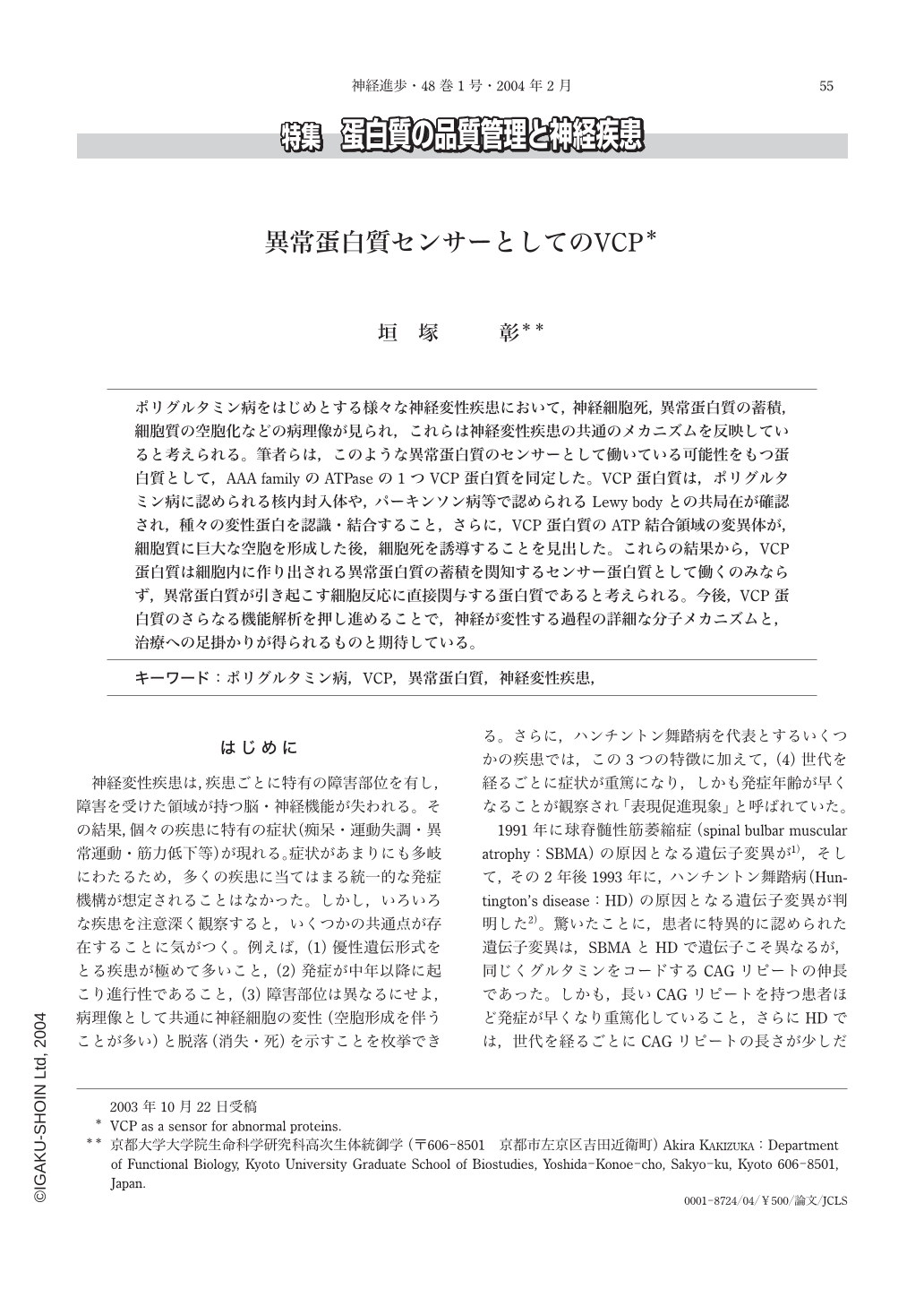Japanese
English
- 有料閲覧
- Abstract 文献概要
- 1ページ目 Look Inside
ポリグルタミン病をはじめとする様々な神経変性疾患において,神経細胞死,異常蛋白質の蓄積,細胞質の空胞化などの病理像が見られ,これらは神経変性疾患の共通のメカニズムを反映していると考えられる。筆者らは,このような異常蛋白質のセンサーとして働いている可能性をもつ蛋白質として,AAA familyのATPaseの1つVCP蛋白質を同定した。VCP蛋白質は,ポリグルタミン病に認められる核内封入体や,パーキンソン病等で認められるLewy bodyとの共局在が確認され,種々の変性蛋白を認識・結合すること,さらに,VCP蛋白質のATP結合領域の変異体が,細胞質に巨大な空胞を形成した後,細胞死を誘導することを見出した。これらの結果から,VCP蛋白質は細胞内に作り出される異常蛋白質の蓄積を関知するセンサー蛋白質として働くのみならず,異常蛋白質が引き起こす細胞反応に直接関与する蛋白質であると考えられる。今後,VCP蛋白質のさらなる機能解析を押し進めることで,神経が変性する過程の詳細な分子メカニズムと,治療への足掛かりが得られるものと期待している。
Many neurodegenerative disorders manifest disease-specific phenotypes(e. g. dementias, ataxias, movement disorders, and spinal cord diseases), and thus it was thought impossible to deduce a common molecular mechanism underlying many, if not all, neurodegenerative disorders. However, protein aggregates and vacuoles are almost universally found in degenerating neurons, suggesting the existence of similar molecular processes in neuronal cell death. In 1994, we identified the gene responsible for Machado-Joseph disease(MJD), and following DNA analyses have identified that MJD is the most common inherited spinocerebellar ataxia. Since then we have elucidated common molecular mechanisms underlying neurodegeneration via molecular analysis of MJD. Not only MJD but also another 8 inherited neurodegenerative diseases, including Huntington's disease have been shown to be caused by the expansion of CAG repeats encoding polyglutamines. Indeed, we have shown that polyglutamines have the ability to self-aggregate and induce neurodegeneration and cell death in transgenic animals(e. g. mouse, rat, and fly)and cultured cells, leading to a proposal of‘polyglutamine disease’. Furthermore, we have identified ter94/VCP, a member of the AAA ATPase, as a polyglutamine-interacting protein via biochemical purification. Interestingly, VCP co-localizes not only with polyglutamine aggregates but also other protein aggregates and Lewy bodies, a neuronal inclusion typically found in Parkinson's disease and a type of dementia. Moreover, profound deficits in its ATPase activity are found to severely affect ER quality control, leading to abnormal ER expansion and cell death, phenotypes frequently observed in many neurodegenerative diseases. These lines of evidence indicate that VCP functions not only as a common sensor for abnormal protein accumulations but also as a mediator of neurodegenerative phenotypes;excessive accumulation of abnormal proteins may inactivate VCP's ATPase in several neurodegenerative disorders, eventually leading to the neurodegenerations. A proper regulation of VCP function is thus proposed to lead to novel treatments that are effective in a broad spectrum of neurodegenerative diseases.
(Received:October 22, 2003)

Copyright © 2004, Igaku-Shoin Ltd. All rights reserved.


